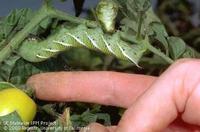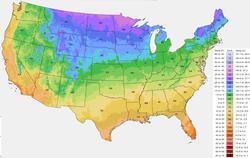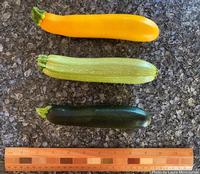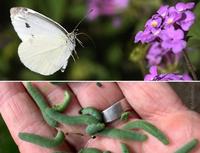Vegetables
Here is a collection of our monthly tips about vegetables.
Vegetable Tips
Asian VegetablesYou can easily grow some vegetables used in different types of Asian cuisine and found in Asian markets. They are not necessarily native to Asia but have found their way into various cuisines. One way to decide which food to grow yourself is to choose varieties that aren't readily available or are more expensive in your local markets. It’s also fun to impress your family, friends, and neighbors with something they may not have seen growing before. Possibilities include sesame seeds, bitter melon, opo, sigua (loofah) in summer and bok choy, napa cabbage, daikon radishes, gai choy in spring or winter.
|
Bolting LettucesIn garden terms, bolting means sending up a flower stalk, not desirable unless you plan to save seeds. Seed packets say lettuce matures in 60–80 days, but the timing also depends on the weather. In warm weather, lettuce matures and bolts much faster. In cool temperatures, seedlings grow more slowly but will still mature and bolt eventually. If the center of the lettuce starts to push upwards, that’s a clue that it’s starting to bolt. Another clue is if you tear a leaf and see milky sap instead of clear juices. Harvest as soon as you notice, before the leaves become unpleasantly bitter.
More information: Growing Lettuce |
Broccoli - Multiple Harvests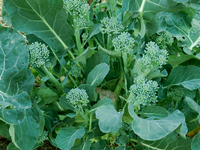
More Information: Growing Broccoli |
Cabbage AphidsThe grey-green cabbage aphid is often found on cool season vegetables. They prefer to feed on the youngest leaves and flowering parts and are often seen on cabbages, broccoli, and Brussels sprouts. Hose them off plants or prune out infestations. Grow flowers in your vegetable garden to attract beneficial insects, which are their natural enemies. See UC Pest Note on Cabbage Aphid to identify and manage this insect. |
Carrot Culture
|
Change to Cool-Season Planting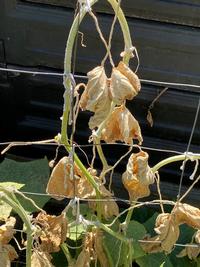
More information: Vegetable calendar
|
Chayote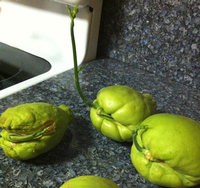
More information: How to grow chayote video
|
Consider Dehydrating Some Of Your HarvestIf you have more fruit than you know what to do with, dehydration can be an excellent way to preserve it. Apricots, apples, pears, figs, and tomatoes are all great candidates for drying. While making jams, jellies, cobblers, and pies is one way to use up an abundant harvest, they add fat and sugar to our diet, dried fruit can be a healthy alternative! Onions and garlic can also be dehydrated to last indefinitely. Also see the publication on Dehydrating Basics by the UCCE Master Food Preservers of Amador/Calaveras Counties. |
Cool-Season Vegetables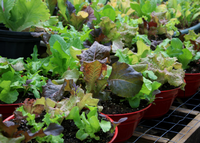
If starting from seed, August is the time to start seedlings for fall vegetables. Broccoli, cauliflower, beets, and fennel will take about 6 weeks to grow to transplant size. Greens such as lettuce, spinach, arugula, chard, and kale will be ready in 4 weeks. So for planting in mid-to-late September, aim to start them in early to mid-August. You can direct seed them on the ground if you have the space. The soil should still be warm enough for seeds to germinate but shade them from the hottest afternoon sun, and keep the seeds moist. If buying transplants from a nursery, you can wait until September. In Santa Clara County, many of the cool-season crops that are planted in September or October can be planted again in February and March. You can get in another crop before it's time to put summer vegetables in the ground. A big advantage of cool-season vegetables is that they need less supplemental water due to lower temperatures, fewer daylight hours, and rain. There are also fewer pest problems in the winter. Cool-season vegetables grow well in temperatures ranging from 55°F to 75°F, at locations with 6–8 hours daily of sun. Check out our videos page for videos on cool season vegetables, including a 3-session course for more inspiration. |
Direct SeedingSome of the larger summer vegetables can be planted from seed directly into the garden this month. These include watermelon, cantaloupe, corn, and summer and winter squash. They tend to have larger seeds, and a rule of thumb is to plant them at a depth of two to three times the diameter of the seed. If you have a seed packet, follow instructions for planting depth, spacing, and thinning. These larger plants tend to grow quickly and out of the reach of many pests that impact small, tender, young seedlings. Amend and thoroughly water the soil before planting so that the seeds are not washed away with watering. Drop the seeds in holes and cover them with soil, or push them down into the soil. Then water again. Keep a close eye on emerging seedlings and protect them from pests as needed.
More information: Planting Vegetable Seeds (Alameda County Master Gardeners)
|
Drought Tip - No Fertilizer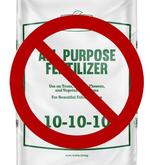
More information: Skip fertilizing |
Drought Tips - Vegetable Gardening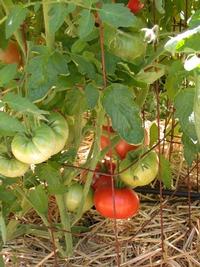
For more information: Ten Tips for Vegetable Gardening during a Drought |
Fall Garden CleanupIt’s an excellent idea to keep the garden clean at all times and to remove dead or dying plants or diseased material. Yet there may be bigger seasonal cleanups when taking out plants that have finished producing or that need to be removed to make room for new plants. Trim woody or overgrown perennials. Remove plant debris that allows insects and diseases to overwinter and then reproduce. Always pick up fruit promptly from the ground to not invite critters or allow diseases to proliferate. It's best to leave fallen leaves in place unless they are diseased. They provide a mulch layer while slowly breaking down and returning nutrients to the soil and then back to the plants. Particularly during a drought, having the soil covered is important for moisture retention. If the leaves are diseased, they need to be removed and put out with the yard waste. Monitor the health of your plants while you're out cleaning up.
More Information: Fall Garden and Landscape Checklist
|
Fusarium WiltThis is the most prevalent and damaging tomato disease. It also starts with the yellowing of lower leaves, but the yellowing may be only on one side (stopping at midrib) of the leaf or just one branch or one side of the plant. The older leaves will droop and curve downward. The yellow leaves wilt and die, gradually killing the whole plant. Sometimes a single shoot is killed before the rest of the plant shows any damage. More information at UC Pest Note on Fusarium Wilt. |
Garlic Harvesting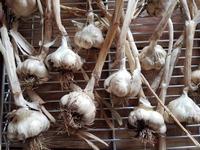
For more information: Garlic |
Gray Mold (Botrytis)Botrytis is gray or brownish fuzzy mold that can attack a wide variety of plants. It likes flower petals, ripening fruits and vegetables, as well as leaves and stems. The spores are spread through the air. It is most severe when there's high humidity and may start forming on decaying matter. According to the UC Pest Note on Botrytis Blight, it is important to remove debris and prunings from the ground. You may even have to pick up flowers daily. Avoid overhead watering. UC also has information about Gray Mold on Strawberries. |
Growing PeppersAs soon as average night time temperatures are above 55° F, peppers can be added to the garden. Before that time, they can be started indoors. Make pepper more productive by planting different varieties closely together. You will get more peppers per square foot because the plants support each other and provide protection from sunburn. Plus, they look lush and beautiful. After planting, it is a good idea to remove flowers and fruit from large-podded plants the first four to six weeks to encourage deeper roots and more foliage. Learn more pepper tips by consulting our Growing Great Peppers and Chiles page. |
Growing Purple Carrots If you only buy carrots at the supermarket, you may think that they are all orange. It is believed that carrots were originally purple, with orange becoming popular through Dutch breeding. Several colors are now available at Farmers’ Markets and by growing your own. Springtime is a good time to start carrots from seed. Transplanting is not advised because you can easily damage the roots which are the relevant plant part. Loose soil is important so that the carrots will grow straight. Scatter the seeds over the soil with as thin a covering as possible, keep moist until germination, and harvest when the tops expand to a good size. The Master Gardeners have done germination and growing experiments with different varieties and soil blends. Covering seeds with a thin layer of vermiculite yielded the fastest and highest rate of germination. Carrots are slow to germinate and could take as long as 3 weeks. Thin to 2 or 3 inches apart. For growing, a soil blend of 1/3 compost and 2/3 soil produced higher-weight carrots than blends with half of the soil replaced with either sand or perlite.
Some common problems are twisted roots from planting too close together, forked or deformed roots from clods and rocks in the soil, a hairy root from too much nitrogen and splitting from too much water. More Information: Growing Carrots |
Growing Transplants from SeedsMany summer vegetables can be started now from seed indoors or in a greenhouse. The ground is still too cold for summer seeds to germinate or for the plants to go into the ground. Depending on the weather we get this spring, it will likely be May or June before the soil is warm enough. The soil in containers or raised beds will warm up earlier in the season.
Starting plants in pots will give them time to get stronger before putting them near potential pests. It will also allow you to continue enjoying current cool-season vegetables. Information found on the seed packages will show which conditions are best for germination. Peppers in particular germinate best with high soil temperature. Using a heating pad is one way that this can be done indoors. Be sure to provide light once the seeds germinate if the seedlings are not in natural sunlight. Seedlings with insufficient light will grow tall and thin and leggy and will not be as strong. When reusing pots for seed starting, prevent the spread of plant diseases by making sure they are clean. Remove any remaining soil and cobwebs; then clean with a 10% bleach solution: 1 part bleach to 9 parts water. If they are growing too large for the pots they are in, transplant them into larger pots. The same can be done for seedlings purchased from a nursery. Transplant them on the ground as suggested under "when to plant" for each vegetable tomatoes, peppers, cucumbers, squash, and melons. This video provides more details on raising your own seedlings. |
Hand Pollinating Squash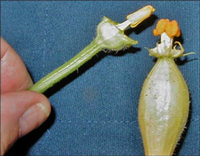
If the squash grows a few inches and then starts to die, it’s probably because the pollination wasn’t successful. More information: Fruit Setting Problem in Cucurbits |
Harden Seedlings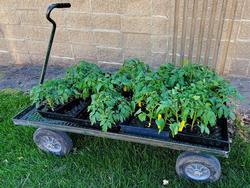
More information: Hardening Transplants |
Harvesting Sweet PotatoesHopefully the timing of your sweet potato harvest will work out for Thanksgiving dinner! They are usually ready 90-100 days after planting, when the end leaves start to yellow. You can dig down a little to see if the potatoes are large enough, but dig carefully or use your hands to avoid accidentally cutting the potatoes. If you plan to store them, cure them in a warm, humid environment for a couple weeks. |
Healthy TomatoesTomatoes are one of the most popular vegetables in home gardens, largely because of the taste difference between a homegrown tomato and a store-bought tomato. Here are a few things to watch out for to keep the plants healthy. Regular watering helps nutrients flow throughout the plant and can prevent blossom end rot. Clean soil and sanitation reduce the common Verticillium wilt in which lower and older leaves turn yellow and brown. And russet mite, where lower leaves and stems appear a greasy bronze, can be controlled with sulfur dust.
|
High Yield VegetablesThere are many considerations for choosing which edibles to plant in your garden. A particularly important one this year may be high yield. The more the plants produce, the more food you will have right on your property. Zucchini naturally comes to mind first. You may need to research additional recipes, and your neighbors may be more amenable this summer to having bags of zucchini dropped on their doorsteps during the night. Other plants that produce a lot are tomatoes and eggplant. Green beans need to be picked almost daily so they will give you an ongoing source of vegetables for a couple of months. Certain cucumbers like Persian cucumbers are eaten small and produce prolifically, enabling you to eat cucumbers more often than if you were waiting for full-size varieties. Vining plants, e.g., melons, will give you more to eat if grown on vertical supports rather than having the produce lie on the ground where it can be more readily eaten by pests.
|
How to Tell if Fruits and Vegetables Are Ready to PickThe UC Davis Postharvest Technology website was designed for commercial growers, but the information on how to tell When Fruits and Vegetables are Mature is handy for home gardeners as well. There's also information about how to Store Fruits and Vegetables for Better Taste. |
Keep Up With Your Vegetable HarvestThe middle of summer is a particularly busy time of year for vegetable gardeners. It can be a challenge to keep up with harvesting—beans can become swollen and tough and zucchinis can become baseball bats! It's particularly important to keep up with plants such as beans because the production of mature seeds (inside the pod) signals the plant to stop producing. Tomatoes can split and rot on the vine in exceptionally hot weather. |
Late Tomatoes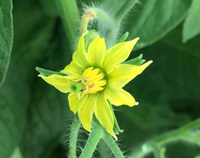
Tomato blossom
More information: Growing tomatoes in the home garden |
LeafminersWatch for damage from leafminers on many types of plants, including leaves of vegetables and commonly on citrus. Eggs can either be inserted into leaves or laid on the surface of leaves. In either case, the larvae feed between leaf surfaces, creating a "mine". If eggs are on the surface of the leaf, they can be rubbed off before hatching. Plant resistant species or varieties. Small seedlings can be protected by protective cloth. On plants such as cole crops, lettuce, and spinach, clip off and remove older infested leaves. Place leaves in plastic bag, and put bag in trash. Leafminers are often kept under good control by natural parasites. Insecticides are not very effective for leafminer control. See UC Pest Note on Leafminers for additional information. |
Leafy Salad Plants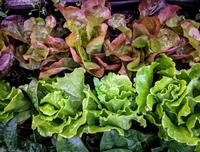
More Information: Growing lettuce in Santa Clara County
|
Mosaic VirusMosaic virus on squash and cucumber plants is a disease spread by aphids and cucumber beetles. The leaves become rough and mottled, the plant becomes stunted and the fruit can be whitish. Pull the plant and put it in the trash. Do not compost. For more information see UC Pest Note on Squash Mosaic Virus. |
Mulch to Conserve Water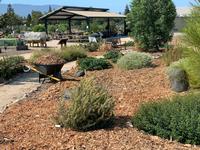
More information: Mulching with Organic Materials |
Neem Oil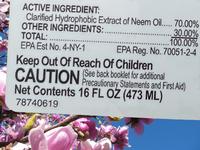
More information: More about Neem |
Onions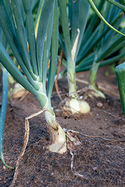
Onions, by Iowa State University
More information: Growing onions |
Peas An old American tradition says that planting peas on St. Patrick’s Day will bring good luck at harvest time. But the best planting date actually depends on the climate where you live. Planting on St. Patrick’s Day in the northeast may lead to a second planting weeks later when frost gets the first batch. Yet in warmer climates like ours, we can plant weeks earlier and may even be eating peas from the garden on St. Patrick’s Day. (We can also plant them here in the fall.) You may want to soak the seeds overnight to help get them ready to germinate. They can be planted directly in the ground, about half an inch deep. Keep the seeds evenly moist until they start to sprout. Provide a trellis or some kind of support for the vertical vines if you are growing pole peas; bush peas can stand on their own.
More Information: Peas
|
Pepper Weevil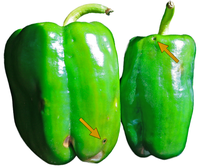
More information: Pepper Weevil |
Plant Asparagus CrownsAsparagus crowns can be planted now. Dig a trench eight to twelve inches deep, mix in fertilizer at the bottom and cover with two inches of soil. Set the roots in the trench about 18 inches apart, and cover with two inches of soil. Gradually fill in the trench as the plants start to grow. Asparagus is a perennial vegetable that will produce for several years. It's best to wait until the second year to harvest to let a strong root system develop for long term production. For more information, read UC Davis' Growing Asparagus in the Garden. |
Plant Cool Season Vegetables again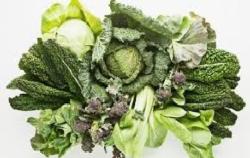
|
Plant Garlic & ShallotsThe time to plant most garlic and shallots is mid-October through the end of November. Fast-growing Dutch Red shallots can mature in just 90 days, so can be planted again in late winter or early spring. Specialty growers guarantee disease-free stock and offer many more garlic varieties than you see at the grocery store, from beefy Chopaka Mountain to beautiful Rose de Lautrec.
Choose the largest cloves and leave the natural papery wrappers on them. Plant them in moist, well-drained soil in a sunny location with the pointy tips up, about one inch deep. Space cloves about four inches apart to leave room for large heads to develop. More information: How to Grow Garlic | How to Grow Shallots |
Potting Mix vs Planting Mix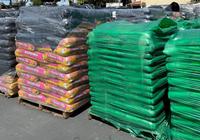
For more information: Bagged Potting Mixes |
Rat Management
Rats show up when your citrus, tomato, or fruit first starts to ripen. Rats are agile climbers and usually live and nest in shrubs, trees, and dense ground cover like ivy. One management strategy is to prevent access to the tree by cutting branches away from fences or other trees, leaving a gap of at least 2–3 feet, good sanitation is required. Garbage and garden debris should be eliminated. Use tight-fitting lids on garbage cans. Thin out dense vegetation to make the habitat less desirable. Mow ivy once a year to the ground. Climbing ivies on fences or buildings should be removed. Per the UC pest note (linked below), trapping is the safest and easiest method for controlling rats. Read the pest note for other management strategies as well. More information: Rat Management |
Root Knot Nematodes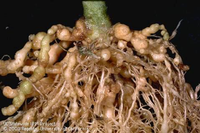
More information: Nematodes Pest Note |
Save Water and Make Your Plants HappierAfter your vegetable garden is well established, it's better to water thoroughly once a week rather than giving it a light watering every day. Doing that will encourage a deeper root system which will help the plants tolerate dry weather better. This is also true for fruit trees. For more information visit UC Pest Note on Watering Fruit and Nut Tress. |
Seed ViabilitySeed packets have a “packed for” date on the back. Yet seeds can still be viable for years beyond that date if stored correctly. Ideal storage conditions are cool and dry. The older the seeds are, the lower the germination rate will be. So plant more of the older seeds than the number of plants you ultimately want. You can do a germination test by putting seeds on a damp paper towel and enclosing them in plastic to keep them uniformly moist. Do this right before planting time so you can transplant the ones that successfully germinate. Or you can take your chances and just plant them directly and see what comes up. If you are saving your own seeds, make sure to choose seeds from the healthiest plants.
Whenever it's hard to find flower seedlings, if you have some old flower seed packets, you can scatter the seeds randomly in a section of your yard and enjoy whatever flowers. More Information: Vegetable Seed Viability
|
Selecting SeedsWhile curled up inside the warm, dry house poring through seed catalogs, how do you decide among all the delightful descriptions? First, be clear on the purpose of your garden. Are you trying to grow exotic food? Do you want to attract native butterflies? Are you interested in flowers you can cut and bring inside? Next, think about the conditions of your site. Is it warm and sunny or is there a lot of shade? Do you have heavy clay soil? Choosing seeds that do well in your area makes for healthier plants with less work. At this point, you have the parameters within which to choose what tickles your fancy. If you would like to save seeds in the future, then choose open-pollinated seeds, including heirlooms. Heirlooms are open-pollinated seeds that have been around for multiple generations. Otherwise, you can plant hybrids that have the best traits of their parent plants but will not reproduce true to type from saved seeds. Follow planting directions on the packet for the best results.
More Information: Seed Saving
|
SquashSummer squashes are meant to be picked and eaten when they are small and tender. These include zucchini, crookneck, chayote, patty pan, and papaya pear squash. Winter squash is grown at the same time as summer squash. What makes it different is that it develops a harder rind that allows it to be stored long term to be used throughout the winter. It can also remain on the vine longer before harvesting. Some examples are butternut squash, pumpkins, and Tahitian squash. Squash plants should be in the ground by now and may already be producing fruit. Continue to water and fertilize them throughout the season and control weeds to ensure maximum production. If squash grows a few inches and starts to wither, it is probably not getting pollinated; you can manually transfer pollen from the male flowers (on stalks) to the female flowers (on developing fruit). An overabundance can be prepared for freezing or shared, or plants can be pulled out early to make room for the next season’s planting.
More Information: Summer Squash, Winter Squash
|
Squash BugsSquash bugs are about ½ long, brownish yellow and flattened like a stink bug. Zucchini is one of their favorite plants. Leaves will blacken and drop as they dry. They can be difficult to control. Placing row cover over young plants helps prevent infestation. Remove nearby vegetation where the bugs can over winter. More information can be read at UC Pest Note on Squash Bug. |
Squirrel Control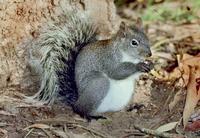
For more information: Pest Note on Tree Squirrels and Pest Note on Ground Squirrels. |
Stake Your BrassicasYour Brussels sprouts and other brassicas may collapse with the weight of the rain. Tying them to a three-foot stake will maximize your chances for a better crop. If you're noticing yellow flowers on your broccoli already, the cold-then-warm temperatures have caused them to bolt; you can try new plants or start thinking ahead to your warm weather garden. |
Summer Vegetables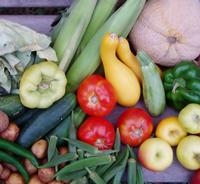
More information: Vegetable gardening |
Sunscald on Fruits and Vegetables
Fruits and vegetables can get sunburned in the summer heat. This is more commonly called sunscald and it frequently affects peppers, tomatoes, and persimmons. The leaves shield the produce from the sun, so it helps to make sure the plants have sufficient fertilizer and water for a healthy plant. You can cut out the damaged parts and eat the rest of the fruit. |
Support Your Vegetables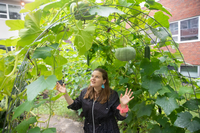
More Information: Trellising, Staking, and Caging |
Testing Soil Moisture DepthYou know how long you water your garden, but do you know how deep the water is going? You don’t need an expensive moisture meter to check. A simple probe can help you find out. Use any item sturdy enough to push a foot or so into the soil, for example, a long screwdriver or metal rod. Push the probe directly into the soil using firm pressure. It will go through moist soil and stop when it hits the underlying dry soil, showing you how deep your water has penetrated. Watering deeply but infrequently is recommended.
More information: Checking Moisture Depth |
Time for Seed Saving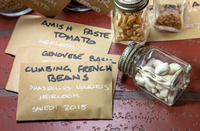
Label and store seeds in airtight containers in a cool, dark place, UC Marin Master Gardeners
More information: How to Save Seeds |
Tomatillo (Physalis philadelphica)
It is a member of the Solanaceae (nightshade) family as is the tomato and will grow any place a tomato will. It is fairly drought tolerant. Being a wild plant, there is a great deal of variability in plant habit, fruit size, etc. It is an annual, a low growing, sprawling plant usually not more than 2 feet high. The tomatillo has small, sticky, tomato-like fruits enclosed in papery husks. They are 1 to 3 inches in diameter and green or purplish in color. Culture is very similar to that for tomatoes or peppers. Plantings are generally direct seeded. The first harvest is ready in 70 - 80 days. They are not ripe until the fruit begins to break through the husk. |
Tomato blossom end rot
|
Tomato Bottom Scarring
Sometimes scarring can be seen on the bottom (blossom end) of tomatoes. This can be caused by weather conditions such as cool and cloudy weather at bloom time, making the blossom stick longer to the small fruit. The fruit is perfectly good to eat with the damaged part cut out. Some large heirloom tomatoes are more susceptible to this condition. Also known as catfacing. |
Tomato HornwormBoth tomato hornworms and tobacco hornworms can do significant damage to tomato plants. They can eat entire leaves and take bites out of the fruit. Although they are large with a striking appearance, they camouflage themselves well on plants and can be surprisingly hard to find. Once you see one, you’ll wonder how you missed it. The first clue to their presence is often a pile of frass (insect larva excrement) on the leaves or ground under the pest. They are up to four inches long so they are easy to handpick for disposal. If you see a row of white eggs on their backs, those are from a parasitic wasp that will take care of the problem naturally. They are striking, with white striping and little round circles. The caterpillars get their name from the horn on their back end, and they are the larval stages of rather large brown moths.
More information: Tomato Hornworms
|
Tomato Russet MiteTomato russet mites deplete juice from the cells of leaves, stems and fruit. They usually start at the base of the plant and move upward. If not controlled, these pests can kill plants. At first sign of damage, treat with sulfur dust or a spray solution of wettable sulfur and spreader-sticker. More information is found in the UC Pest Note on Tomato Russet Mite. |
Tomato StakingIt's time to start planning how you will stake your tomatoes. You will want to stake your tomatoes right after you plant your seedlings. Here are the various Tomato Staking Techniques we have tried. |
USDA Hardiness ZonesPlanting zones help you select plants that are right for your garden. There are two systems, USDA and Sunset Western Garden.
USDA divides the US into hardiness zones based on average high and low temperatures. Most of Santa Clara County is in zones 9b and 10a. Sunset makes many finer distinctions, taking into consideration rainfall patterns, ocean influence, and more. In the Sunset system, Santa Clara County is largely zones 15 or 16 with some zone 7 for areas with more extreme highs and lows. Sunset zone maps: Central and South County and North County. For gardening success, choose plants known to thrive in your zone. |
Vegetable Garden Check-InThis is a good time in the season to evaluate your vegetable garden to see what’s producing well, what you can improve, and what to give up on and chalk up to experience. Take notes! If a plant is barely growing, could it benefit from a shot of fertilizer or some extra water? Might you have planted it out too early in a cooler-than-usual spring when both daytime and nighttime temperatures were still too cool? If it’s not getting six to eight hours of sun per day, can you move it to another spot or put reflective material nearby to give extra sunlight? Did you use a new soil that perhaps had a different blend of materials? Is part of it being eaten or affected by the disease? Observe closely, including on the underside of leaves and at night. Harvest regularly and promptly. And remember the old gardening adage, “There’s always next year.”
More information: Vegetable Diagnostic |
Vegetable Planting ChartWondering what vegetables can be planted now? To get the best success—whether planting from seed or transplants—refer to our Santa Clara County Vegetable Planting Chart. It's based on our own garden experiences. |
Verticillium WiltVerticillium wilt is a soil-borne fungal disease that damages plant veins. The damage is characterized by affecting one side of the plant. The leaves may wilt and turn brown, dying upward from the base of the branch to the tip. Dead leaves often fall, but may not. Mildly affected plants may survive if fertilized and encouraged into vigorous growth. The fungus can live for years in the soil. Planting tomatoes, peppers, eggplants, and potatoes (all members of the Solanaceae or nightshade family) in the same place no more than once every three years helps reduce the fungal population to non-harmful levels. Soil solarization may eliminate Verticillium wilt from infected soils. Crop rotation with cereals or broccolis can reduce the pathogen. Avoid high nitrogen fertilizers. Plant Verticillium wilt-resistant varieties of tomatoes, potatoes or strawberries. Refer to the UC Pest Note information on Tomato, Potato, and Strawberry for species-specific suggestions. |
Water BudgetingWe always need to use water wisely. Sometimes it is necessary to stop and think about your landscape and prioritize water use. Trees are a long-term investment, yet mature trees may have extensive root systems enabling them to find enough water on their own. Fruit trees may need watering approximately monthly during the summer in order to produce good fruit. Vegetables should always be given adequate water in order to fulfill their purpose in the garden; otherwise the little bit of water you used will have been wasted if the garden is not feeding you well. It’s helpful to understand that home-grown vegetables use much less water overall than ones purchased at the store. Established flowering shrubs, especially California natives, tend to need less water than annual flowers and maybe a more water-efficient way to have color and beauty in your garden. Lastly, keep the weeds under control so that they don’t rob water from the plants that you actually want.
More Information: Water Use Classification of Landscape Species (WUCOLS)
|
When to Start Summer Vegetables from Seed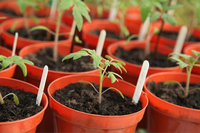
More Information: Growing Transplants from Seed |
White Butterflies and Green CaterpillarsHave you seen these small yellowish-white butterflies fluttering around? Cabbage white butterflies feed on many flowers, but for laying their eggs. They favor the cabbage family, such as broccoli, cauliflower, and mustard. The velvety green caterpillars, also called imported cabbageworms, feed on the leaves after hatching. While mature plants tolerate a few holes munched in their leaves, young seedlings don't have foliage to spare. Cultural controls include handpicking the caterpillars, brushing the eggs off the undersides of leaves, and using row covers to protect the seedlings. UC lists additional options in the link below.
More information: Managing Imported Cabbageworms |
White Mold on Lettuce and Brussels SproutsWhite mold is a distinctive disease that most often affects stems and foliage at the base of cole crops* and lettuce plants. Affected tissue develops a soft, watery rot and white, cottony mycelium forms on the surface. Plants may wilt if stems are girdled by the decay. As affected tissue dries up, it turns yellow to white, and hard black sclerotia form on the surface or inside the dead stems. Get more information in the UC Pest Note on White Mold. * Cole crops include broccoli, Brussels sprouts, cabbage, cauliflower, collards, kale, and kohlrabi |
Winter IrrigationDepending on the fall weather and rain frequency, you will likely set your sprinklers to water less frequently or even turn them off for a while. It's still important to check outdoor plants to ensure they have enough water. While they need less water when it's cool, it's important to make sure they don't dry out. If you have a lawn and rains haven't come, irrigate the lawn once or twice this month. If it has been raining, the soil may be saturated, so be careful if you have to walk on it to not compact it. Also, if the soil is waterlogged, vital space for air needed for plants and worms, and excess water can drown beneficial soil organisms and contribute to rotting roots. |
Winter Squash HarvestingWinter squash is ready to pick when the stem begins to shrivel. Press the rind with your fingernail, it should resist denting. Pick before the first hard frost and cure by letting it lie in the sun for at least 3 days, turning it each day. Store in a cool, dry place. It will keep for up to 5 months. |
Winter Vegetables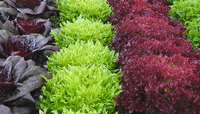
|







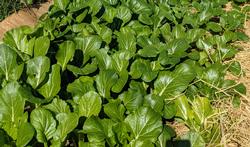
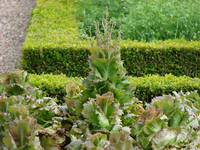
 If you have a light fluffy soil, perhaps in a raised bed, you can grow those long beautiful carrots you see in the grocery store. However most of us have a heavy clay soil and it is best to grow the shorter varieties. Adding organic material such as compost rather than manure is good. The seeds are very tiny and mixing sand with them will help you not over-seed. Plant no more than 1/2 inch deep. Carrots are slow to germinate and could take as long as 3 weeks. Keep the soil moist until they're up. Thin to 2 or 3 inches apart. Plant every few weeks for a continuous crop. If you have limited space, try growing in among your ornamentals, their feathery tops can look quite pretty. They can also be grown in a container. Some common problems are twisted roots from planting too close together, forked or deformed roots from clods and rocks in the soil, hairy root from too much nitrogen and splitting from too much water.
If you have a light fluffy soil, perhaps in a raised bed, you can grow those long beautiful carrots you see in the grocery store. However most of us have a heavy clay soil and it is best to grow the shorter varieties. Adding organic material such as compost rather than manure is good. The seeds are very tiny and mixing sand with them will help you not over-seed. Plant no more than 1/2 inch deep. Carrots are slow to germinate and could take as long as 3 weeks. Keep the soil moist until they're up. Thin to 2 or 3 inches apart. Plant every few weeks for a continuous crop. If you have limited space, try growing in among your ornamentals, their feathery tops can look quite pretty. They can also be grown in a container. Some common problems are twisted roots from planting too close together, forked or deformed roots from clods and rocks in the soil, hairy root from too much nitrogen and splitting from too much water.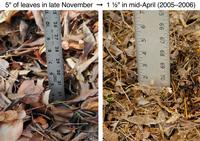
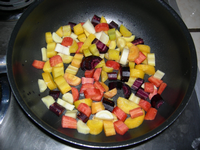
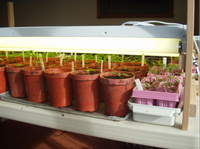
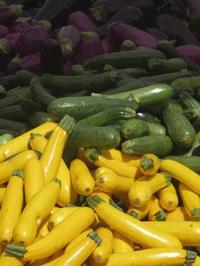
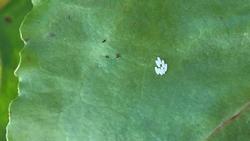
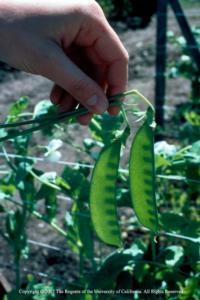
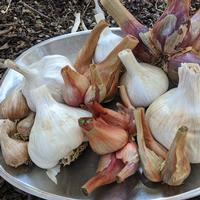
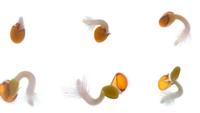
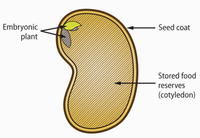
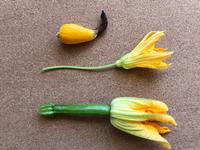
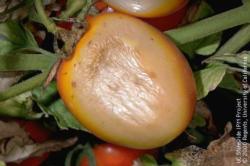
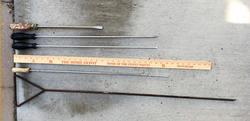
 Tomatillos still to this day is a truly wild plant. Attempts to hybridize them have failed. The plant is native to Mexico and was brought to the U.S. by Mexican Indian immigrants. It has a tart green apple taste and is the main ingredient in green salsas. It is also used in soups, stews, and guacamole.
Tomatillos still to this day is a truly wild plant. Attempts to hybridize them have failed. The plant is native to Mexico and was brought to the U.S. by Mexican Indian immigrants. It has a tart green apple taste and is the main ingredient in green salsas. It is also used in soups, stews, and guacamole. A brown depression on the bottom of tomatoes is usually blossom end rot (BER). This disorder is related to a calcium deficiency aggravated by irregular watering. Since most soils have adequate calcium, watering is usually the problem. Without regular watering, the calcium in the soil cannot reach the plant. Mulching can help. Water tomatoes regularly. Avoid flooding them so the roots sit in water. For more detailed information about BER please view
A brown depression on the bottom of tomatoes is usually blossom end rot (BER). This disorder is related to a calcium deficiency aggravated by irregular watering. Since most soils have adequate calcium, watering is usually the problem. Without regular watering, the calcium in the soil cannot reach the plant. Mulching can help. Water tomatoes regularly. Avoid flooding them so the roots sit in water. For more detailed information about BER please view 
